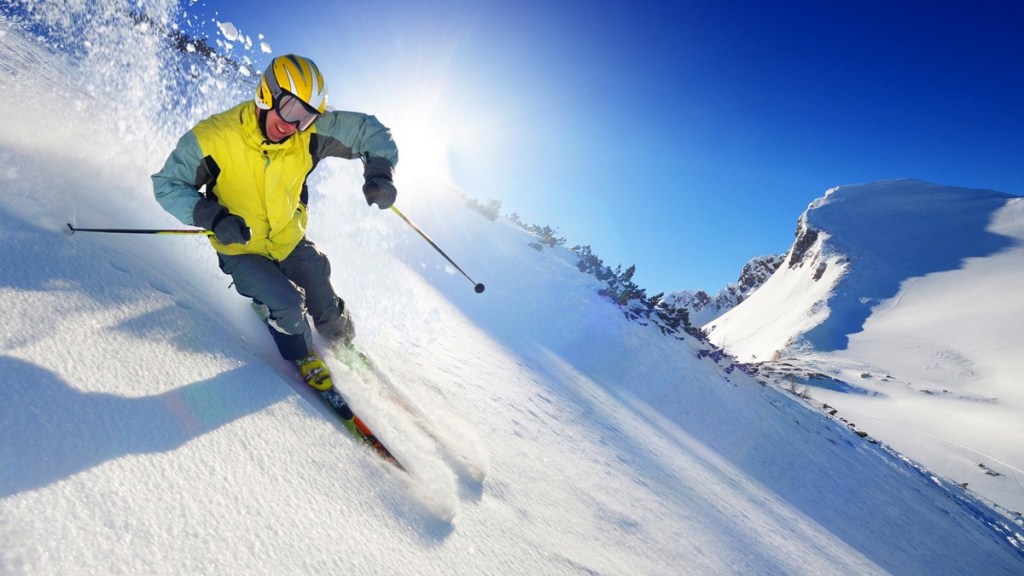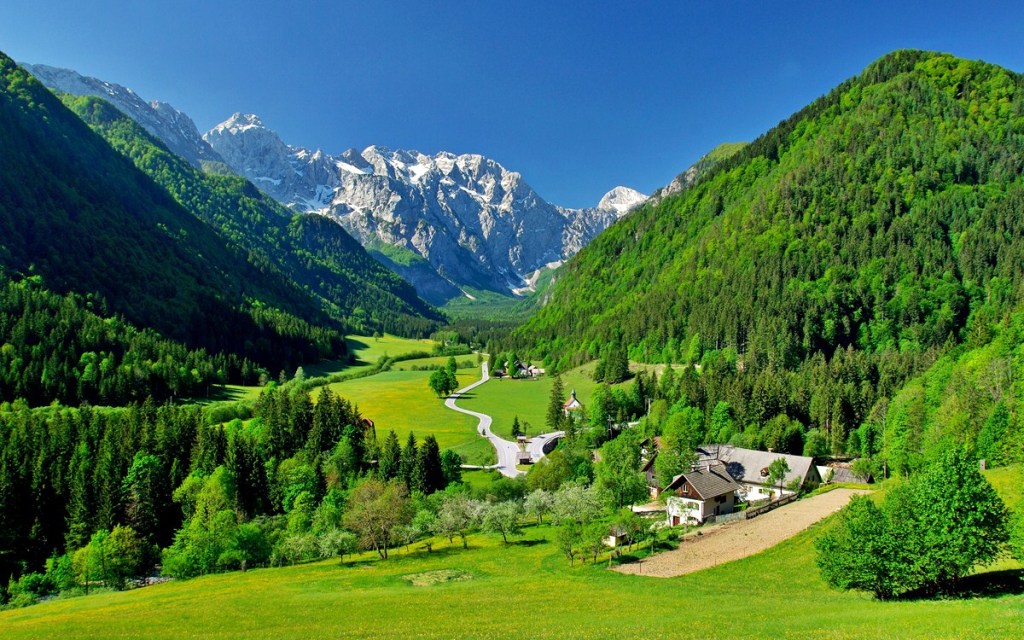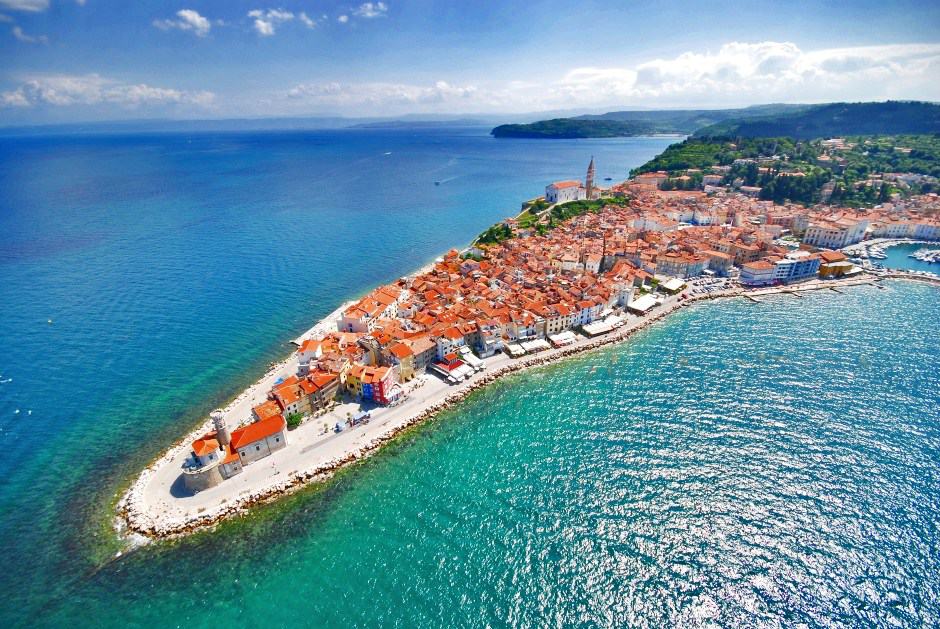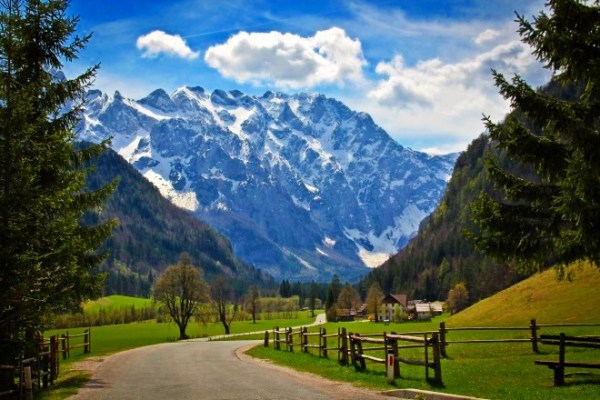Sandwiched between Italy, Croatia, Hungary and Austria, Slovenia might be small but it’s a surprisingly diverse country. Venture just an hour or so from the compact capital, Ljubljana, and you’ll find nearly 50 kilometres of sunny Adriatic coastline, tranquil wine regions and the stunning Lake Bled, backed by the soaring Julian Alps. Travel a little further and you’ll hit the dramatic Logarska Dolina, karst plateaus riddled with cave systems and Maribor, the country’s engaging second city. To find out more, we’ve explored the country season by season.
Winter

Whether you want an adrenaline-pumped holiday trying out activities like ice climbing, snow rafting or winter mountain biking or you’ll rather relax in a fine mountain chalet with your family just skiing down occasionaly on the slopes; a winter holiday in Slovenia can provide you both.
The location of Slovenia in Central Europe guarantees plenty of snow from December till mid-March especially in the mountain areas like the Julian Alps and Kranska Gora.
In January-February the temperatures fall just below zero during the day which combined with the lots of sunshine the mountain slopes get make sure you pursue your winter activities within pleasant weather conditions. At nights tempretaures usually drop well below zero allowing the lakes and waterfalls to froze enough so ice skating on them will be safe.
In all, there are 87 ski resorts in Slovenia, 10 of which are of a major scale, 18 medium sized and 59 more compact ski villages. The total area of resorts amounts to 1300 hectares, comprising of 300 km of ski runs, 280 km cross-country paths and 24 km of sledging tracks. Slovenia ski resorts are subject to continual improvement and, year on year, management and safety levels have been repeatedly increased. To ensure full season skiing almost three quarters of all tracks are supplemented by artificial snow making.
Tracks for cross-country skiers wind their way past picturesque lakes and over plateaus such as in Pokljuka where, every year, the world biathlon championships take place, or across Bloke Plateau, one of Europe’s oldest ski bowls. Cross-country tracks are well established in the Logarska Valley and can frequently be found close to some of Slovenia’s smaller and more popular local resorts.
Other more unexpected Winter pursuits include snowmobiling in Kranjska Gora, Pohorje, Pokljuka and Krvavec and, in some places, dog and horse-driven sledge rides. Around any of Slovenia’s resorts, for five minutes of fun you can grab a one or two man sled and speed downhill on numerous toboggan tracks, or sledge downhill on snowy roads that cross mountain passes (normally closed in winter) organised by qualified sports agencies.
Spring

Ljubljana’s not a grittily atmospheric place; anyone expecting post-Communist grimness will be sorely disappointed. Like Croatia’s capital, Zagreb, there are echoes of the Hapsburg dynasty which once ruled this part of the world, a central European gentility you can still see in the city’s Art Nouveau buildings.
Spring brings riots of colour in the city streets after the grey gloom of winter; the streets alive with flowers . The cafes crowding around the river banks – especially along Cankarjevo Nabresze, across the river from the university – is a great place for people watching and candid photography. One of the cafes, Macek, includes dozens of pictures of drinkers and people promenading outside on its walls; proof that it’s one of the best spots in the city to watch the world go by. In spring this is even more.
Slovenia’s most scenic spot, however, isn’t the capital, but Lake Bled, about 50km northwest of the capital. Located in the foothills of the Julian Alps, the lake is well-known to rowers and kayakers (it’s held the World Rowing Championships four times) but even more famed for its castle and church. Bled Castle, arranged on a rocky precipice looking out over the northern shore of the lake, is a Gothic masterpiece and a stunning photographic location in its own right. But it’s the tiny island in the middle of the lake that has made Bled a postcard favourite.
The Assumption of Mary Pilgrimage Church sits on Bled Island, a forested teardrop in Lake Bled’s icy glacial water. There’s only one way out here – unless you fancy swimming – and that’s to take the rowboats that line the quayside in Bled town.The lake’s cold, clear waters are beautifully flat, and at the island’s edges huge lake fish cruise silently under the tree shadows. The Slovenian tourist authorities haven’t been shy about making the most of this lake-based highlight, but it’s not hard to find peaceful spots. This part of the Julian Alps is not short of hiking trails, and many of those surrounding Bled give dazzling views of the lake and the castle.
Summer

It may have only 42km of coast but in Slovenia it’s quality not quantity that counts. Squashed between Italy and Croatia, the Slovenian coast is full of colourful Italian-style fishing villages, olive groves and clean, clear water. It’s an idyllic place to go for a slice of Mediterranean sunshine, and since it’s easily accessible by budget airline from Trieste, it’s also cheap and easy to get to.
The Italians, Germans and Croats have long known about Slovenia’s scenic coast, but it has only recently begun to register on the global travelers consciousness. In 1990, it became the first state to break away from the former Yugoslavia, and it is clearly enjoying its independence.
Visitors can flit between the four main coastal resorts along the coast. It’s easiest by car, but flat coastal paths link Piran with Portoroz and Koper with Isola, so hiring bikes is a practical option. And because Slovenia is roughly the size of Wales, it’s easy, even on a weekend break, to explore some of the country’s other attractions, either by hire car or locally arranged tour.
Autumn

Autumn is a beautiful time to visit the far west of Slovenia. The leaves of the Malvazija, Jakot and Rebula vines are flecked with gold, amber and pink. Light breezes rustle the olive and permission bushes, and pigs fattening for this year’s pršut, or prosciutto, snuffle obliviously in the gentle sunshine. The odd hiker traversing the Alpe Adria Trail and tractors trundling in with the harvest are the only interruptions.
The Slovenian region of Goriška merges seamlessly into Italy’s Friuli-Venezia Giulia; and surveying the rolling hills and scattering of red-roofed farmhouses, you’d be forgiven for thinking that you were across the border. This part of Slovenia has a character quite different to the misty mountains around Lake Bled and the busy towns of the Adriatic coast. The country might be small, but it packs a lot into twenty thousand square kilometres.
Yet there’s more than just natural beauty here. Goriška is home to some of Europe’s most exciting winemakers – known for their natural orange wines – and thanks to a growing number of B&Bs and wine routes, this is the perfect time to discover them.
 Balkan Incoming DMC Travel news, destinations and options in Balkan region
Balkan Incoming DMC Travel news, destinations and options in Balkan region



